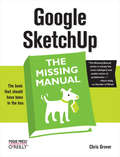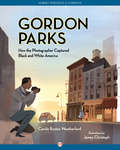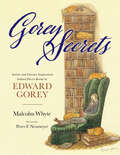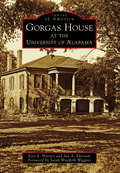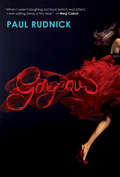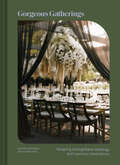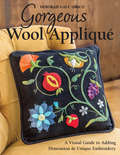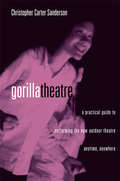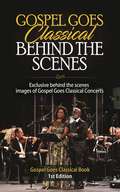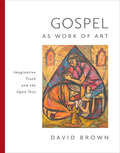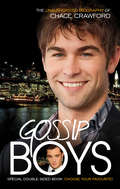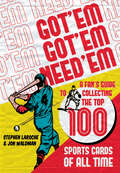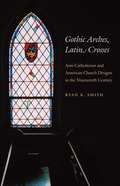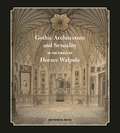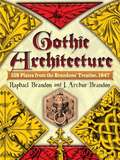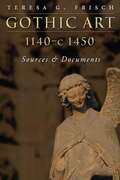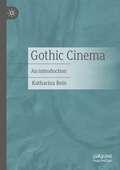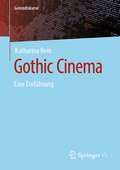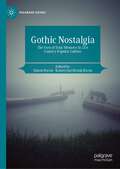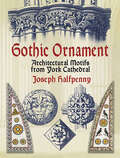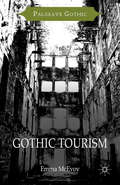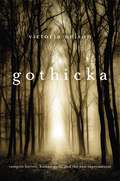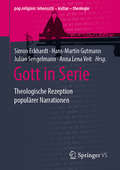- Table View
- List View
Google SketchUp: The Missing Manual (Missing Manual)
by Chris GroverIf you want to learn to create 3-D models using Google SketchUp, this Missing Manual is the ideal place to start. Filled with step-by-step tutorials, this entertaining, reader-friendly guide will have you creating detailed 3-D objects, including building plans, furniture, landscaping plans -- even characters for computer games -- in no time. Google SketchUp: The Missing Manual offers a hands-on tour of the program, with crystal-clear instructions for using every feature and lots of real-world examples to help you pick up the practical skills you need. Learn to use the basic tools, build and animate models, and place your objects in Google Earth. With this book, you will:Learn your way around the SketchUp workspace, and explore the differences between working in 2-D and 3-DBuild simple 3-D shapes, save them as reusable components, and use SketchUp's Outliner to show or hide them as you workTackle a complicated model building with lots of detail, and discover timesaving tools for using many componentsAnimate the model by creating an interior walkthrough of your buildingDress up your model with realistic material shading and shadows, and place it in Google EarthIt's easy to get started. Just download the program from Google.com, and follow the instructions in this book. You'll become a SketchUp master in a jiffy.
Gordon Parks: How the Photographer Captured Black and White America
by Carole Boston Weatherford Jamey ChristophGordon Parks is most famous for being the first black director in Hollywood. But before he made movies and wrote books, he was a poor African American looking for work. When he bought a camera, his life changed forever. He taught himself how to take pictures and before long, people noticed. This is a fixed-format ebook, which preserves the design and layout of the original print book.
Gorey Secrets: Artistic and Literary Inspirations behind Divers Books by Edward Gorey
by Malcolm WhyteEdward Gorey (1925–2000) was a fascinating and prolific author and artist. Of the one hundred delightful and fascinating books that Gorey wrote and illustrated, he rarely revealed their specific inspirations or their meanings. Where did his intriguing ideas come from? In Gorey Secrets: Artistic and Literary Inspirations behind Divers Books by Edward Gorey, Malcolm Whyte utilizes years of thorough research to tell an engrossing, revealing story about Gorey’s unique works. Exploring a sampling of Gorey’s eclectic writings, from The Beastly Baby and The Iron Tonic to The Curious Sofa and Dracula, Whyte uncovers influences of Herman Melville, Agatha Christie, Edward Lear, the I Ching, William Hogarth, Rene Magritte, Hokusai, French cinema, early toy books, eighteenth-century religious tracts for children, and much more.With an enlightening preface by Gorey collaborator and scholar Peter F. Neumeyer, Gorey Secrets brings important, uncharted insight into the genius of Edward Gorey and is a welcome addition to collections of both the seasoned Gorey reader and those who are just discovering his captivating books.
Gorgas House at the University of Alabama (Images of America)
by Jun A. Ebersole Sarah Woolfolk Wiggins Erin E. HarneyBuilt in 1829, the Gorgas House is the oldest structure on the University of Alabama campus. Originally constructed to serve as a hotel, housing for the university steward, and student dining hall, the building underwent several renovations to meet the needs of an ever-changing and growing campus. Later utilized as a faculty residence, classroom, post office, and infirmary, the Gorgas House was one of the few buildings to survive the destruction of campus near the end of the Civil War. Standing as a lasting reminder of the university's antebellum past, the house is preserved today as a museum dedicated to the legacy of the building's final residents, the Gorgas family.
Gorgeous
by Paul RudnickA book that will make you see yourself clearly for the first time.When Becky Randle's mother dies, she's whisked from her trailer park home to New York. There she meets Tom Kelly, the world's top designer, who presents Becky with an impossible offer: He'll design three dresses to transform the very average Becky into the most beautiful woman who ever lived.Soon Becky is remade as Rebecca -- pure five-alarm hotness to the outside world and an awkward mess of cankles and split ends when she's alone. With Rebecca's remarkable beauty as her passport, soon Becky's life resembles a fairy tale. She stars in a movie, VOGUE calls, and she starts to date Prince Gregory, heir to the English throne. That's when everything crumbles. Because Rebecca aside, Becky loves him. But the idea of a prince looking past Rebecca's blinding beauty to see the real girl inside? There's not enough magic in the world.Defiant, naughty, and impossibly fun, GORGEOUS answers a question that bewilders us all: Just who the hell IS that in the mirror?
Gorgeous Gatherings: Designing Unforgettable Weddings and Luxurious Celebrations
by Alison HotchkissFilled with inspiration for your next party, this stunning lookbook combines beautiful imagery of celebrations around the world with practical advice for designing your own unforgettable events.Travel from the coast of Japan to the beaches of Mexico, from New York City to the Utah desert, and discover how a professional planner designs exquisite celebrations inspired by the world’s most stunning destinations. In these pages, Alison Hotchkiss—named best wedding planner by Vogue, Harper’s Bazaar, and Goop, and widely recognized in the event industry as a creative luminary—reveals the process of choosing the color palette, flowers, paper goods, textiles, menus, music, and other travel-inspired details to create memorable parties with a sense of place. Helpful tips and how-tos for designing bespoke weddings and events are woven throughout, such as:Making a mood boardConstructing a floral chandelierChoosing your first dance songDealing with inclement weatherCrafting a sweet send-off giftAnd so much moreBrimming with breathtaking photos and insightful guidance, Gorgeous Gatherings is essential inspiration for brides and hostesses and a blissful armchair escape to faraway places and fabulous soirees.RENOWNED AUTHOR: Alison Hotchkiss is one of the world's most talented and renowned wedding and event planners. Her co-writer, Elizabeth Graves, is the editor-in-chief of Martha Stewart Living and the former editor-in-chief of Martha Stewart Weddings. They've distilled their combined decades of experience into this stunning guide, ensuring it's packed with beautiful details and essential party-planning wisdom.ASPIRATIONAL AND INSPIRATIONAL IDEAS: Jaw-dropping photography makes this a fun-to-flip-through lookbook, but the pages are also filled with practical advice and achievable how-tos for replicating aspects of these amazing events at home. Gorgeous Gatherings makes table design and entertaining feel fun and inspiring to hostesses, décor enthusiasts, flower lovers, brides, and anyone who wants to elevate their gatherings. BEAUTIFUL TO GIFT AND DISPLAY: A gorgeous event planning book with a textured cover and tip-on photo, this makes a lovely gift for a hostess or bride-to-be who will enjoy getting lost in all the alluring images. With tons of flower photos and tablescaping tips, it also makes a lovely gift alongside a vase, set of coupe glasses, or beautiful table linen. Display this stunning book on a coffee table next to Arranging Things, Call It Home, and Natural Tables.PARTIES AND WEDDINGS: This book offers advice for planning weddings, anniversary parties, birthday celebrations, garden parties, showers, and fetes for any special occasion.Perfect for:Brides, mothers of brides, engaged couplesShoppers looking for an engagement or housewarming giftHosts, hostesses, and anyone who likes to entertainReaders of Martha Stewart Living, Real Simple, and The KnotFans of Pacific Natural, Gathering: Setting the Natural Table, Live Beautiful, Platters and Boards, and Call It Home
Gorgeous Wool Appliqué: A Visual Guide to Adding Dimension & Unique Embroidery
by Deborah Gale Tirico“There's more to felted wool appliqué than folk art, as needle artist Tirico demonstrates in this collection of colorful projects.” —Library Journal Sewing with luxurious felted wool, discover the secrets to dimensional appliqué that will add depth and drama to your home decor. Take your embroidery skills to the next level with eight colorful projects including penny rugs, pincushions, and pillows. Easy-to-learn techniques such as thread-matching, needle-slanting, and fabric-layering will help you achieve clean and sharp lines every time! This clear, visual guide includes links to printable, full size patterns with placement and embroidery guides.
Gorilla Theater: A Practical Guide to Performing the New Outdoor Theater Anytime, Anywhere
by Christopher Carter SandersonFirst Published in 2003. Routledge is an imprint of Taylor & Francis, an informa company.
Gospel Goes Classical Behind the Scenes: Exclusive Behind the Scenes Images of Gospel Goes Classical Concerts. (Gospel Goes Classical Book 1st Edition #1)
by Steve LaneExclusive Behind the Scenes Images of Gospel Goes Classical Concerts.
Gospel as Work of Art: Imaginative Truth and the Open Text
by David BrownA lushly illustrated, magisterial exploration of the imaginative truth of the gospel In the modern academy, truth and imagination are thought to be mutually exclusive. But what if truth can spring from other fonts, like art, literature, and invention? The legacy of the Enlightenment favors historical and empirical inquiry above all other methods for searching for truth. But this assumption stymies our theological explorations. Though the historicity of Jesus&’s life, death, and resurrection is important, it is not of sole importance. For instance, is John&’s Gospel any less &“true&” than the Synoptics just because it&’s less historically accurate? David Brown challenges us to expand our understanding of the gospel past source criticism and historical Jesus studies to include works of imagination. Reading Scripture in tandem with works of art throughout the centuries, Brown reenvisions the gospel as an open text. Scholars of theology and biblical studies, freed from literalism, will find new avenues of revelation in Gospel as Work of Art. This volume includes over one hundred color illustrations.
Gossip Boys: The double unauthorised biography of Ed Westwick and Chace Crawford
by Liz KayeOMG. It's Chuck Bass and Nate Archibald from Gossip Girl in one book. We're all mad about the boys, but is it Ed Westwick's bad-guy allure that ticks your box, or Chace Crawford's pretty-boy looks? Or - naughty - both? Well, to help you decide, Gossip Boys, the unauthorised double biography of Chace and Ed, charts the lives of these hot young things, who are best friends both on the show and in real life. Brit-born Westwick has the edgy cool of his character, having fronted the indie band The Filthy Youth, and appearing in cult films such as Son of Rambow and Children of Men. Crawford meanwhile is the ultimate all-American idol, signed by the first talent agent who interviewed him and being named 'Summer's Hottest Bachelor' by People and winning the Teen Choice Award for 'Male Hottie'. The huge success of Gossip Girl has seen these actors become two of the biggest pin-ups around, and favourites of magazines like Grazia and teen TV programming such as T4. Now you can learn all about the boys: their early days, their flames old and new, their careers and the bromance that has made them scorching stars.
Got 'Em, Got 'Em, Need 'Em: A Fan's Guide to Collecting the Top 100 Sports Cards of All Time
by Jon Waldman Stephen LarocheFor over a hundred years, kids of all ages have enjoyed the thrill of collecting sports cards. Whether it was souvenirs from their parents&’ cigarette packs, pieces that came in bubble gum packages, or the modern dazzlers, the simple formula of pictures and text on cardboard have been a part of North American society for over a century.Now, take a look back at one of the most popular hobbies in history with Got &’Em, Got &’Em, Need &’Em. Covering baseball, basketball, football, hockey, boxing, and golf, this unique book offers a look at the greatest sports cards ever produced, including the players and personalities involved. Relive the days gone by with some of the industry&’s most well-known experts as we count down the best from the business.Plus, as a special bonus, take a look at the best innovations, the worst blunders, and a special tribute to the hobby&’s boom era in the 1990s.
Got 'Em, Got 'Em, Need 'Em: A Fan's Guide to Collecting the Top 100 Sports Cards of All Time
by Jon Waldman Stephen LarocheFor over a hundred years, kids of all ages have enjoyed the thrill of collecting sports cards. Whether it was souvenirs from their parents&’ cigarette packs, pieces that came in bubble gum packages, or the modern dazzlers, the simple formula of pictures and text on cardboard have been a part of North American society for over a century.Now, take a look back at one of the most popular hobbies in history with Got &’Em, Got &’Em, Need &’Em. Covering baseball, basketball, football, hockey, boxing, and golf, this unique book offers a look at the greatest sports cards ever produced, including the players and personalities involved. Relive the days gone by with some of the industry&’s most well-known experts as we count down the best from the business.Plus, as a special bonus, take a look at the best innovations, the worst blunders, and a special tribute to the hobby&’s boom era in the 1990s.
Gothic Arches, Latin Crosses
by Ryan K. SmithCrosses, candles, choir vestments, sanctuary flowers, and stained glass are common church features found in nearly all mainline denominations of American Christianity today. Most Protestant churchgoers would be surprised to learn, however, that at one time these elements were viewed with suspicion as foreign implements associated strictly with the Roman Catholic Church. Blending history with the study of material culture, Ryan K. Smith sheds light on the ironic convergence of anti-Catholicism and the Gothic Revival movement in nineteenth-century America.Smith finds the source for both movements in the sudden rise of Roman Catholicism after 1820, when it began to grow from a tiny minority into the country's largest single religious body. Its growth triggered a corresponding rise in anti-Catholic activities, as activists representing every major Protestant denomination attacked "popery" through the pulpit, the press, and politics. At the same time, Catholic worship increasingly attracted young, genteel observers around the country. Its art and its tangible access to the sacred meshed well with the era's romanticism and market-based materialism.Smith argues that these tensions led Protestant churches to break with tradition and adopt recognizably Latin art. He shows how architectural and artistic features became tools through which Protestants adapted to America's new commercialization while simultaneously defusing the potent Catholic "threat." The results presented a colorful new religious landscape, but they also illustrated the durability of traditional religious boundaries.
Gothic Architecture and Sexuality in the Circle of Horace Walpole
by Matthew M. ReeveGothic Architecture and Sexuality in the Circle of Horace Walpole shows that the Gothic style in architecture and the decorative arts and the tradition of medievalist research associated with Horace Walpole (1717–1797) and his circle cannot be understood independently of their own homoerotic culture. Centered around Walpole’s Gothic villa at Strawberry Hill in Twickenham, Walpole and his “Strawberry Committee” of male friends, designers, and dilettantes invigorated an extraordinary new mode of Gothic design and disseminated it in their own commissions at Old Windsor and Donnington Grove in Berkshire, Lee Priory in Kent, the Vyne in Hampshire, and other sites. Matthew M. Reeve argues that the new “third sex” of homoerotically inclined men and the new “modern styles” that they promoted—including the Gothic style and chinoiserie—were interrelated movements that shaped English modernity. The Gothic style offered the possibility of an alternate aesthetic and gendered order, a queer reversal of the dominant Palladian style of the period. Many of the houses built by Walpole and his circle were understood by commentators to be manifestations of a new queer aesthetic, and in describing them they offered the earliest critiques of what would be called a “queer architecture.” Exposing the role of sexual coteries in the shaping of eighteenth-century English architecture, this book offers a profound and eloquent revision to our understanding of the origins of the Gothic Revival and to medievalism itself. It will be welcomed by architectural historians as well as scholars of medievalism and specialists in queer studies.
Gothic Architecture and Sexuality in the Circle of Horace Walpole (G - Reference, Information And Interdisciplinary Subjects Ser.)
by Matthew M. ReeveGothic Architecture and Sexuality in the Circle of Horace Walpole shows that the Gothic style in architecture and the decorative arts and the tradition of medievalist research associated with Horace Walpole (1717–1797) and his circle cannot be understood independently of their own homoerotic culture. Centered around Walpole’s Gothic villa at Strawberry Hill in Twickenham, Walpole and his "Strawberry Committee" of male friends, designers, and dilettantes invigorated an extraordinary new mode of Gothic design and disseminated it in their own commissions at Old Windsor and Donnington Grove in Berkshire, Lee Priory in Kent, the Vyne in Hampshire, and other sites. Matthew M. Reeve argues that the new "third sex" of homoerotically inclined men and the new "modern styles" that they promoted—including the Gothic style and chinoiserie—were interrelated movements that shaped English modernity. The Gothic style offered the possibility of an alternate aesthetic and gendered order, a queer reversal of the dominant Palladian style of the period. Many of the houses built by Walpole and his circle were understood by commentators to be manifestations of a new queer aesthetic, and in describing them they offered the earliest critiques of what would be called a "queer architecture." Exposing the role of sexual coteries in the shaping of eighteenth-century English architecture, this book offers a profound and eloquent revision to our understanding of the origins of the Gothic Revival and to medievalism itself. It will be welcomed by architectural historians as well as scholars of medievalism and specialists in queer studies.
Gothic Architecture: 158 Plates from the Brandons' Treatise, 1847
by Raphael Brandon J. Arthur BrandonThis comprehensive study of Gothic architecture traces the distinctively beautiful elements of Gothic style through the medieval churches of Europe. Gathered from a rare two-volume Victorian classic, over 700 meticulously rendered details and illustrations display every intricate aspect of Western culture's most magnificent ecclesiastical structures, including London's Westminster Abbey Church. The only edition of these antique architectural plates in print, this splendid book is a one-of-a-kind source of authentic Gothic design.In page after fascinating page, this rich retrospective features the finest examples of medieval masonwork, woodwork, and metalwork dating back to the thirteenth century. Explore the soaring Gothic characteristics of vaulted ceilings, arched windows, flying buttresses, pointed spires, ornamental filials, and decorative panels, plus doorways, moldings, roofing, porches, door hinges, and other elaborate architectural elements.Filled with fascinating insights into the creation of Gothic-style churches and cathedrals, this sweeping survey also provides lively observations of the medieval period.
Gothic Art 1140-c1450: Sources And Documents
by Teresa G. FrischAn anthology offering a chronological assessment of a whole range of technical documents on art written by and for clerks, laymen, churchmen, lawyers, city magistrates, and guilds, this text reveals differences in milieu, customs, resources and psychology during different periods. First Published in 1971 by Prentice Hall.
Gothic Cinema: An introduction
by Katharina ReinGothic Cinema closes a gap in German-language film discourse: for the first time, the volume sheds light on a hitherto little-discussed film context. It considers Gothic Cinema as a form of unofficial historiography that allows a look not only at the history of film and its technique, but also at moral concepts, gender relations, collective fears or aesthetic currents. A delimitation and definition of the term and the central elements of the Gothic are followed by a comprehensive historical overview from 1896 to the present day. Three in-depth analyses of individual post-2015 gothic films and television series round out the review. On the one hand, the examples examined are representative in terms of typical elements, motifs or topoi, and on the other hand, they exhibit peculiarities and breaks that prove fruitful for a cultural and media studies investigation.
Gothic Cinema: Eine Einführung (Genrediskurse)
by Katharina ReinMit Gothic Cinema schließt sich eine Lücke im deutschsprachigen Filmdiskurs: Erstmalig beleuchtet der Band einen bislang wenig diskutierten Filmzusammenhang. Er betrachtet das Gothic Cinema als als eine Form inoffizieller Historiographie, die einen Blick nicht nur auf die Geschichte des Films und seiner Technik, sondern auch auf Moralvorstellungen, Geschlechterverhältnisse, kollektive Ängste oder ästhetische Strömungen zulässt. Auf eine Abgrenzung und Bestimmung des Begriffs und der zentralen Elemente des Gothic folgt ein umfassender historischer Überblick von 1896 bis zur heutigen Zeit. Drei ausführliche Analysen einzelner Gothic-Filme und Fernsehserien nach 2015 runden die Betrachtung ab. Die untersuchten Beispiele sind einerseits repräsentativ im Hinblick auf typische Elemente, Motive oder Topoi und weisen andererseits Besonderheiten und Brüche auf, die sich für eine kultur- und medienwissenschaftliche Untersuchung als fruchtbar erweisen.
Gothic Nostalgia: The Uses of Toxic Memory in 21st Century Popular Culture (Palgrave Gothic)
by Simon Bacon Katarzyna Bronk-BaconThis book is an original and innovative study of how Gothic nostalgia and toxic memory are used to underpin and promote the ongoing culture wars and populist politics in contemporary popular culture. The essays collected here cover topics from the spectral to the ecological, deep fakes to toxic ableism, Mary Poppins to John Wick to reveal how the use of an imaginary past to shape the present, creates truly Gothic times that we can never escape. These ‘hungry ghosts’ from the past find resonance with the Gothic which speaks equally of a past that often not only haunts the present but will not let it escape its grasp. This collection will look at the confluence between various kinds of toxic nostalgia and popular culture to suggest the ways in which contemporary populism has resurrected ideological monsters from the grave to gorge on the present and any possibility of change that the future might represent.
Gothic Ornament: Architectural Motifs from York Cathedral
by Joseph HalfpennyThese royalty-free motifs feature exquisite specimens of the sculptured ornaments from northern Europe's largest medieval cathedral. The Cathedral and Metropolitical Church of St. Peter in York, popularly known as York Minster, was founded as a missionary church. Its soaring Gothic architecture and vast interior, parts of which date back to the 13th century, feature some of the best examples of the medieval craftsman's work to be found anywhere.This compilation consists of 175 illustrations, selected from throughout the cathedral. Like the building of the church itself, the ornaments were executed during different eras. This collection, reproduced from a rare 18th-century volume, offers artists and graphic designers an unusual selection of authentic architectural motifs from the Middle Ages.
Gothic Tourism: Constructing Haunted England (Palgrave Gothic)
by Emma McEvoyFrom Strawberry Hill to The Dungeons, Alnwick Castle to Barnageddon, Gothic tourism is a fascinating, and sometimes controversial, area. This lively study considers Gothic tourism's aesthetics and origins, as well as its relationship with literature, film, folklore, heritage management, arts programming and the 'edutainment' business.
Gothicka
by Victoria NelsonThe Gothic, Romanticism's gritty older sibling, has flourished in myriad permutations since the eighteenth century. In Gothicka, Victoria Nelson identifies the revolutionary turn it has taken in the twenty-first. Today's Gothic has fashioned its monsters into heroes and its devils into angels. It is actively reviving supernaturalism in popular culture, not as an evil dimension divorced from ordinary human existence but as part of our daily lives. To explain this millennial shift away from the traditionally dark Protestant post-Enlightenment Gothic, Nelson studies the complex arena of contemporary Gothic subgenres that take the form of novels, films, and graphic novels. She considers the work of Dan Brown and Stephenie Meyer, graphic novelists Mike Mignola and Garth Ennis, Christian writer William P. Young (author of The Shack), and filmmaker Guillermo del Toro. She considers twentieth-century Gothic masters H. P. Lovecraft, Anne Rice, and Stephen King in light of both their immediate ancestors in the eighteenth century and the original Gothic-the late medieval period from which Horace Walpole and his successors drew their inspiration. Fictions such as the Twilight and Left Behind series do more than follow the conventions of the classic Gothic novel. They are radically reviving and reinventing the transcendental worldview that informed the West's premodern era. As Jesus becomes mortal in The Da Vinci Code and the child Ofelia becomes a goddess in Pan's Labyrinth, Nelson argues that this unprecedented mainstreaming of a spiritually driven supernaturalism is a harbinger of what a post-Christian religion in America might look like.
Gott in Serie: Theologische Rezeption populärer Narrationen (pop.religion: lebensstil – kultur – theologie)
by Simon Eckhardt Hans-Martin Gutmann Julian Sengelmann Anna Lena VeitDer Sammelband beschäftigt sich mit Serien als festem Bestandteil gegenwärtiger Popkultur, die Erzählmuster bekannter Hollywoodformate ablösen. In den Großerzählungen der Serienlandschaft werden religiöse Themen explizit und implizit verhandelt und zum handlungstragenden Element.
